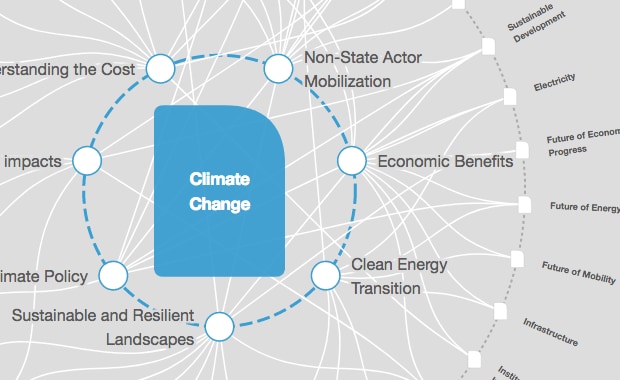地球温暖化による世界の気温上昇、「1.5℃」と「2℃」では大きな差

世界の平均気温の上昇をどの程度まで抑えることができるか。もし2℃に達すれば、夏の北極海では海氷が消えるという現象も珍しくなくなるだろう。
- 地球温暖化によって世界の平均気温が産業革命以前の水準よりも2℃上昇すれば、膨大な数の人が生死に関わるリスクにさらされる恐れがあります。
- 気温上昇を1.5℃に抑えることができれば、水ストレスに悩まされる人の数を半減できるなど、あらゆる影響を軽減できると言われています。
- 気温上昇が2℃に達すれば、夏の北極海では海氷が消えるという現象も珍しくなくなるでしょう。
- 温暖化を食い止めるためには、効果的なエネルギー転換の推進が不可欠。しかし、一部の専門家は、現状のエネルギー転換の進展ペースは遅すぎると指摘します。
地球温暖化による世界の平均気温の上昇を1.5℃に抑えるのか、それとも2℃に抑えるのか。日光浴を楽しんだり、自宅で暖房を調節して快適に過ごしたりする場面では、その影響に大差はないかもしれません。しかし、地球をどれほど温暖化させているかという点では、将来、膨大な数の人々を生死の危機にさらす気候問題を誘発しかねないのです。
世界の平均気温が産業革命以前よりも1.5℃上昇した場合、夏の北極海で100年に一度、海氷が消える現象が発生すると予測されています。一方、平均気温の上昇が2℃に達すれば、その現象が発生する頻度は10年に一度になるかもしれません。気候変動に関する政府間パネル(IPCC)が、数年前に公表した「1.5℃特別報告書」には、この0.5℃という気温上昇の違いがどれほど大きな影響の差を生む可能性があるのかが記載されていますが、北極海の海氷に関するこの予測はその一例に過ぎません。
産業革命以前を基準とする現在の目標
2015年に196の国と地域によって採択されたパリ協定は、世界の平均気温の上昇を産業革命以前の水準から2℃未満にするとともに、1.5℃に抑制するように努力することを目標に掲げています。
この「産業革命以前の水準」には大きな意味があります。IPCCの「1.5℃特別報告書」には、1850年から1900年の気温を現在の気温との比較の基準として採用していると記載されています。
過去のIPCCの報告書の共同執筆者であり、オックスフォード大学で地球システム科学の教授を務めるマイルズ・アレン氏は、1.5℃という目標は「物理的、技術的、そして経済的にも達成可能」としています。
アレン教授は、2018年に執筆した英国王立国際問題研究所(チャタム・ハウス)への寄稿文の中で「世界の平均気温の上昇を1.5℃に抑えるという目標を達成するには、世界全体のGDPの約2.8%を2050年までにエネルギーシステムに投資する必要がある」と語っています。「1.5℃という目標がなかったとしても、世界のGDPの約2%をエネルギーシステムに投資することになるでしょう。エネルギーはどのみち賄っていかなければならないため」。
世界の平均気温上昇の現状
IPCCは、人間の活動による気温上昇は、2017年の時点で産業革命以前に比べて約1℃(0.8~1.2℃の間である可能性が高い)であり、現在は10年につき0.2℃の割合で上昇を続けていると警鐘を鳴らしています。
これらの上昇値は世界の平均値であり、一部の地域ではこの平均値を上回る温暖化が起きています。IPCCによると、世界人口の20~40%が、2006年から2015年の間に少なくとも一つの季節で1.5℃以上の気温上昇を経験したとのこと。温暖化の進行度には地域によってばらつきがあるのです。
米国航空宇宙局(NASA)が公表した報告書「懸念すべき温度:なぜ世界の気温変化を注視すべきなのか」には、「気温の上昇速度は、地域によって異なり、一般的に海よりも陸の方が上昇値が高い。温暖化が最も顕著に現れているのは、寒冷な季節の北極圏と温暖な季節の中緯度の地域である」と記されています。

温暖化を食い止めるための行動
すでに述べたように、IPCCは、気温上昇が2℃に達すれば夏の北極海では海氷が消えるという現象も珍しくなくなっていくと懸念しています。このまま温暖化に歯止めがかからなければ、その他の異常な気象現象の発生も避けることはできません。現に、さまざまな異常気象がすでに観測されています。
世界の平均気温が2℃上昇した場合に発生するとみられる気候や天候によるその他の主な現象は、オーストラリアの非営利団体である気候評議会によっていくつか指摘されています。その中には、サンゴ礁の壊滅的な打撃や多くの昆虫種の生息環境の消失が含まれています。また、世界人口の3分の1以上が少なくとも5年に一度の割合で異常な猛暑に見舞われるとの予測も示されています。
気候変動の影響による水ストレスの問題も拡大の一途をたどっていますが、NASAによると、世界の平均気温の上昇を2℃ではなく1.5℃に抑えることができれば、気候変動に起因する水ストレスに悩まされる人の数を半減できるとのことです。具体的な数字では、2050年までに1億8,400万人から2億7,000万人が水ストレス問題から逃れることが可能になる計算です。その一方でNASAは、世界の平均気温の上昇が2℃に達すれば、世界の一部では危険なレベルの降水量を記録し、今年7月中旬にヨーロッパの一部で甚大な爪痕を残したものに匹敵する洪水を引き起こす恐れがあることも指摘しています。
科学者も活動家も、地球温暖化の最悪のシナリオを回避するには、二酸化炭素の排出量を削減すると同時に、その最善策として世界のエネルギーシステムを再構築するための抜本的な対策を講じる必要があるとの意見で一致しています。世界経済フォーラムの「効果的なエネルギー転換の促進2021年報告書」では、世界115カ国のエネルギーシステムの動向についての調査結果が公表されています。それによると、エネルギーシステムで着実な改善がみられるのはわずか10%にすぎません。
同報告書によると、世界の経済大国トップ10のうちでエネルギー転換を効果的に推進している国のトップ10に名を連ねたのは英国とフランスだけでした。化石燃料の消費量が世界でも最大クラスの国で十分な進展がみられないことがエネルギーシステム改善において大きな懸念材料となっていると同報告書は指摘しています。
このトピックに関する最新情報をお見逃しなく
無料アカウントを作成し、パーソナライズされたコンテンツコレクション(最新の出版物や分析が掲載)にアクセスしてください。
ライセンスと転載
世界経済フォーラムの記事は、Creative Commons Attribution-NonCommercial-NoDerivatives 4.0 International Public Licenseに基づき、利用規約に従って転載することができます。
この記事は著者の意見を反映したものであり、世界経済フォーラムの主張によるものではありません。
最新の情報をお届けします:
地球を救う方法
アジェンダ ウィークリー
世界の課題を読み解くインサイトと分析を、毎週配信。






